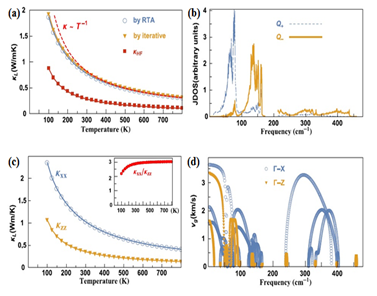As thermoelectric materials can directly convert heat to electricity and vice versa, they have been attracting increasing attention from both theoretical and technical sides. The conversion efficiency is governed by the dimensional figure of merit ZT = S2σT/κ, where S, σ, and κ T are, respectively, the Seebeck coefficient, the electrical conductivity, and the thermal conductivity. S2σ is the so-called power factor. Band engineering and multi-scale scattering can synergistically manipulate the electronic and phonon transport, and significantly enhance the thermoelectric performance. Recently, Jiang’s group at the Ningbo Institute of Materials Technology and Engineering, Chinese Academy of Sciences investigated the thermoelectric performance for several candidates by a combination of first-principles calculations and zone-melting method.
(1) SnTe-based materials: The electronic structures of M-doped SnTe (M = Mg, Mn, Cd, and Hg) are investigated by using first-principles calculations. It is found that Sn vacancy plays an important role in the band engineering of SnTe. The enlarged band gap and reduced energy separation between two valence bands (Fig. 1) both lead to the increase of Seebeck coefficients, which is explicitly confirmed by the followed experimental measurements. The zone-melted SnTe systems alloyed with additional Mn significantly improves the Seebeck coefficient with the highest value of ~ 270 μV/K and a record power factor of 31.9 μW/cmK2 at 820 K. The maximum thermoelectric figure of merit ZT of ~ 1.25 is obtained at 920 K for the high quality crystalline ingot of p-type SnMn0.07Te. These results have been published recently in RSC Adv. 2015, J. Mater. Chem. A 2015, Phys. Chem. Chem. Phys. 2016, and RSC Adv. 2016.

Fig. 1 Calculated band structure of undoped, Mn-doped and Cd-doped SnTe
(2) SnSe-based materials: The recently reported ZT value of SnSe single crystal reached 2.6, which is the highest value among those of the bulk thermoelectric materials. The single crystal of SnSe has poor mechanical properties, and requires very strict growth conditions. Polycrystalline material is regarded to overcome these difficulties, Jiang’s group have investigated the thermoelectric properties of textured SnSe-based polycrystalline by zone-melting method. Fig. 2a is the SEM image of the prepared textured SnSe polycrystalline, and the corresponding power factor and ZT value are 9.5 μW/cmK2 and 0.9 at 873 K, respectively (Fig. 2b). The zone-melted ingot was then pulverized into powders and the bulk material was prepared by the spark plasma sintering technique. As a result, the ZT value was enhanced to be over 1.0, owing to the slight reduction of lattice thermal conductivity and maintenance of electrical performance (Fig. 2c). Our calculations show that Ag doping could promote the valence bands convergence and enhance the Seebeck coefficient of SnSe, which is confirmed by the followed experiments. The power factor and ZT value are enhanced to 11 μW/cmK2 and 1.3 (Fig. 2d). Moreover, n-type SnSe compound has been synthesized by doping BiCl3 and a high power factor of ~ 5 μW/cmK2 as well as a ZT of 0.7 have been achieved at 793 K. These results have been published recently in J. Mater. Chem. C 2016, and Appl. Phys. Lett. 2016.

Fig. 2 (a) The SEM image of the prepared textured SnSe polycrystalline, and (b) the corresponding ZT value; (c) the thermal conductivity of SnSe sample prepared by pulverization and the spark plasma sintering technique; and (d) the ZT value of Ag-doped SnSe.
(3) BiCuOSe: First-principles calculations are employed to investigate the phonon transport of BiCuOSe. Our calculations reproduce the lattice thermal conductivity of BiCuOSe. The calculated grüneisen parameters around 2.5 at room temperature, a fairly large value indicating a strong anharmonicity in BiCuOSe, which leads to its ultralow lattice thermal conductivity. The contribution to total thermal conductivity from high-frequency optical phonons, which are mostly contributed by the vibrations of O atoms, is larger than 1/3 (Fig. 3a), remarkably different from the usual picture with very little contribution from high frequency optical phonons. Our calculations show that both the high group velocities and low scattering processes (Fig. 3b) involved make the high-frequency optical modes contribute considerably to the total lattice thermal conductivity. In addition, we show that the sound velocity and bulk modulus along a and c axes exhibit strong anisotropy (Fig. 3d), which results in the anisotropic thermal conductivity in BiCuOSe (Fig. 3c).These results have been published recently in Sci. Rep. 2016.

FIG 3. Phonon transport of BiCuOSe.(a)Calculated average lattice thermal conductivities with respect to temperature, κHFdenotes the contributions to total lattice thermal conductivity from the high-frequency (above 213 cm−1)optical modes.(b)Frequency-dependent JDOS for scattering rate.(c)Temperature-dependent κxx and κzz of BiCuOSe. The inset of the figure shows the ratio of κxxto κzz.(d)Group velocities along Γ-X and Γ-Z.
The work is financially supported by the National Natural Science Foundation of China (No. 11234012,11374063, 11404348, and 11404350), Ningbo Municipal Natural Science Foundation (Grant No. 2014A610011), Zhejiang Provincial Science Fundation for Distinguished Young Scholars (LR16E020001), and Ningbo Science and Technology Innovation Team (No. 2014B82004).
Prof.Jun Jiang : jjun@nimte.ac.cn Dr. Xiaojian Tan:tanxiaojian@nimte.ac.cn
All Images by ![]()

